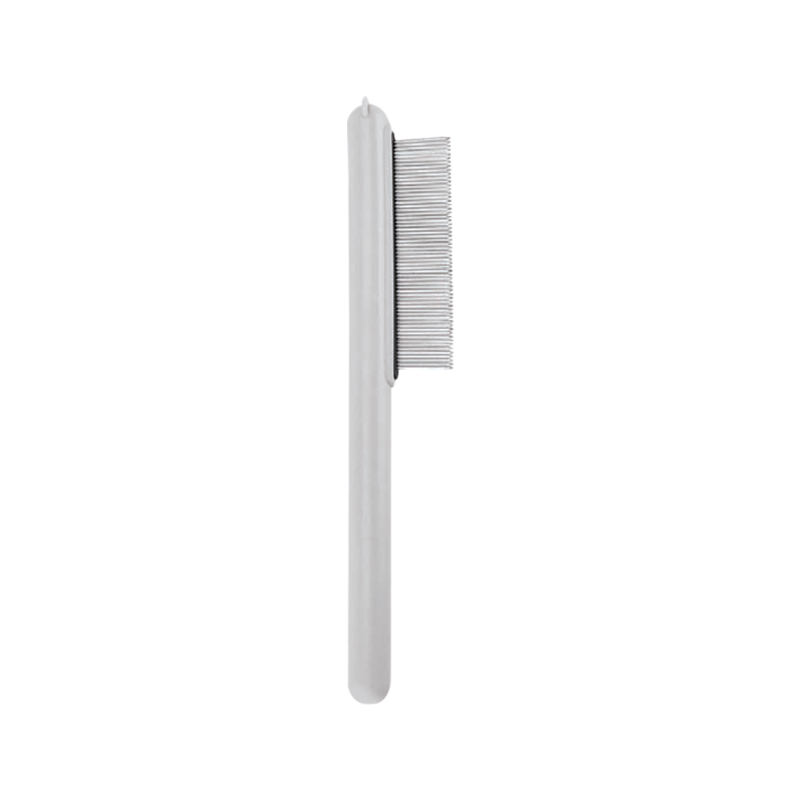Amidst the continued growth in pet care demand, Pet Grooming Comb Factory has become a crucial component in ensuring the supply of pet health and grooming tools. By integrating technological research and development, material science, and production management, these factories are committed to providing safe, practical, and market-leading grooming tools. Taking Tallfly, an industry player, as an example, through clear production standards and continuous innovation, they demonstrate how pet grooming comb factories balance product performance and commercial sustainability. This article will address common issues, gradually analyzing the factory's operational logic and explaining how it achieves multi-faceted value through specific measures.
What key factors should pet grooming comb factories consider during the design phase?
Design is the foundation of product development. During the design phase, pet grooming comb factories must comprehensively consider the tool's compatibility with pet skin, user experience, and production feasibility. In the early stages of development, the design team will identify the specific hair type of the combing target, such as double hair, curly hair, or short hair, and determine the geometric shape, density, and inclination angle of the comb teeth based on the hair characteristics. At the same time, the factory will combine ergonomics to design a handle structure that is comfortable to hold and not easy to slip, so as to reduce hand fatigue caused by long-term use.
From a technical perspective, the design needs to specify the radius range of the comb tooth tips to avoid scratches on the skin caused by sharp angles or spikes. In addition, the spacing between the comb teeth should be kept within a reasonable range to reduce hair entanglement or pulling. From a commercial perspective, a sound design helps factories reduce product overlap, optimize inventory management, and enhance market acceptance by delivering product features that meet user needs.
How does prototyping help factories validate product designs?
Prototyping is a critical link between design and mass production. Pet grooming comb factories typically use a hierarchical prototype verification process: first, a prototype is made using rapid prototyping technology to check the preliminary effects of the comb tooth arrangement and handle shape; then, a functional prototype is made using materials consistent with actual production and put into simulation testing. The testing process includes a robotic arm simulating combing movements, measuring the force exerted by the comb teeth on simulated skin and hair samples, and evaluating the product's resistance to wear and aging.
Prototype testing allows factories to identify potential structural flaws or material incompatibilities and make adjustments before mass production. This process not only reduces the cost of late-stage modifications but also helps shorten product launch times, giving factories a competitive edge in the market.
What material properties affect the safety and durability of a comb?
Material selection directly impacts the safety and lifespan of a product. Pet grooming comb manufacturers often choose high-performance polymers, stainless steel, or treated hardwood as the main materials. The polymer material must have good impact resistance and be non-toxic to ensure that the comb teeth have a smooth surface and are not prone to breakage after injection molding. Stainless steel, due to its corrosion resistance and structural stability, is suitable for combs that require frequent disinfection. Wooden combs need to be treated with moisture-proof and wear-resistant treatment to avoid mildew or cracking.
In technical implementation, different materials correspond to different processing techniques: polymers require control of melting temperature and mold accuracy; stainless steel requires precision processing and edge passivation; wood requires cutting, polishing and coating protection. From a commercial perspective, the right material selection helps factories control production costs, reduce return rates, and build brand credibility through the long-term use of their products.
How can the consistency and safety of comb tooth shape be ensured during production?
The consistency and safety of the comb teeth depend on the mold quality and production process control of the pet grooming comb factory. Factories usually use high-precision CNC technology to make molds to ensure that the comb tooth shape, spacing and top curvature meet design specifications. Key areas of the mold are hardened and polished to slow down wear and reduce dimensional deviations during production. For metal comb teeth, factories may use broaching or stamping processes, combined with finishing methods such as tumbling to remove burrs.
Using statistical process control methods, factories can monitor fluctuations in key comb tooth dimensions and perform mold maintenance before they exceed acceptable limits. This refined control not only reduces user complaints due to comb tooth defects, but also improves production yield, thereby supporting factory cost optimization and delivery stability.
What inspection steps do factories use to ensure defect-free products?
Pet grooming comb factories implement multiple inspection procedures on the production line to identify and reject substandard products. The manual inspection station uses a standard light source and magnification tool to screen the comb tooth arrangement and surface finish. Automated measuring equipment performs quantitative testing on the comb tooth spacing and handle connection strength. In addition, the factory regularly conducts mechanical performance tests on samples, such as tensile tests and drop tests, to evaluate the structural strength and impact resistance of the products.
These inspection measures can effectively reduce the probability of defective products entering the market and reduce after-sales maintenance costs. At the same time, stable quality performance helps factories establish long-term cooperation with retail channels and supports the brand's accumulation of trust on the consumer side.
How does the factory ensure that the materials used are pet-friendly?
Material safety is a fundamental requirement for pet grooming comb factories. The factory samples and tests each batch of incoming raw materials to identify harmful substances or potential migrating components. For polymer materials, the laboratory will simulate the actual use environment to conduct extractable tests to ensure that the materials will not release adverse ingredients when they come into contact with pet skin or hair. Metal materials must comply with relevant surface treatment standards to prevent heavy metal precipitation.
Furthermore, the factory uses supplier audits and batch traceability to ensure the reliable source of raw materials and can quickly switch supply channels when necessary. Sound supply chain management not only ensures product safety but also enhances the factory's ability to cope with market fluctuations.

How do factories evaluate the structural reliability of combs through mechanical testing?
Mechanical testing is an important means of verifying the structural safety of products. Pet grooming comb factories use tensile tests to evaluate the strength of the connection between the handle and the comb teeth, fatigue tests to simulate changes in material properties under long-term use, and impact tests to verify the product's ability to resist breakage when accidentally dropped. During the testing process, the factory uses a device that simulates pet skin and hair to quantify the force applied to the hair roots during combing, and adjusts the comb tooth structure and material selection accordingly.
This test data provides the factory with a basis for optimizing product design, thereby reducing the risk of breakage or damage during use. From a commercial perspective, structurally reliable products can reduce warranty claims and negative feedback, maintaining brand image and customer loyalty.
How does surface treatment technology improve the product experience?
Surface treatment is a crucial process for enhancing the safety and feel of pet grooming combs. The factory uses processes such as tumbling, vibration polishing or micro-grinding to remove burrs and sharp corners on the teeth and handles to make the surface smooth and flat. For plastic parts, it may be possible to eliminate surface micropores through laser annealing; for metal parts, corrosion resistance can be enhanced through electrolytic polishing. The grip may have micro-texture or soft covering to improve grip stability and comfort.
These treatments not only make the product gentler on pets, but also increase users' willingness to use it. Good tactile and visual effects can enhance the product's appeal at the retail end and support factories in achieving differentiated competition.
How do factories manage product quality through traceability systems?
Traceability systems are a core tool for pet grooming comb factories to implement quality management. Each batch of products is marked with a unique identification code, which is linked to the raw material batch, production equipment and testing records. When receiving market feedback, the factory can use the identification code to quickly locate the scope of the problem, retrieve relevant production data, and determine whether it is an individual deviation or a systemic problem.
Traceability mechanisms help factories narrow down the scope of problematic products, reducing recall costs and the risk of business disruption. At the same time, it conveys the factory's attitude of being responsible for quality to channel partners and consumers, and enhances confidence in cooperation.
How does sustainability influence factories' material and production decisions?
With growing consumer awareness of environmental protection, pet grooming comb factories are gradually adopting sustainable practices. For example, a factory might use recycled polymers in its products or choose recyclable or compostable packaging options. At the same time, by optimizing mold design and production processes, material waste and energy consumption can be reduced.
From a business perspective, sustainable initiatives not only comply with regulatory trends but also attract environmentally conscious consumers, creating potential market growth opportunities for factories. Furthermore, using durable materials and recyclable designs helps extend product lifecycles, indirectly supporting the factory's long-term resource conservation efforts.
How can factories ensure product integrity during transportation through packaging design?
Packaging is an important step for pet grooming comb factories to ensure that products are delivered to users in good condition. The factory will select lining materials with cushioning properties to prevent the comb teeth from deforming or breaking during transportation. The outer packaging must be moisture-resistant and pressure-resistant to adapt to various logistics environments. Product information and instructions for use must be clearly marked on the packaging surface to help consumers make correct choices and operations.
Through simulated shipping tests, factories can verify the protective effects of their packaging solutions, reducing returns or exchanges due to logistics damage. A positive packaging experience also helps enhance customer recognition of the brand's professionalism.
How can factories leverage production data to improve quality and efficiency?
Modern pet grooming comb factories are gradually deploying digital monitoring systems to collect real-time production parameters such as mold temperature and injection pressure.
 English
English 中文简体
中文简体 русский
русский

